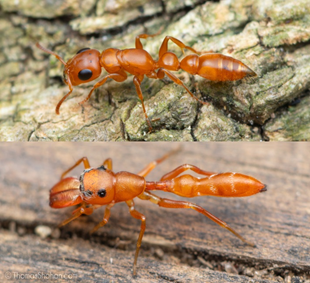Context
Recently, Money spider, an ant-mimicking spider, was discovered at Wayanad Wildlife Sanctuary.
About Money Spider
- Money spiders, commonly found in European meadows, have been reported for the first time in the country from the Muthanga range of the Wayanad Wildlife Sanctuary
- The species is called so as it is “believed to bring luck” to the person who comes in contact with it.
- The spider belongs to the family of dwarf spiders (Linyphiidae) under the genus Prosoponoides.
- It has been given the name Prosoponoides biflectogynus.
- Only six species of spiders belonging to this genus have been identified from across the world so far.
- It is the first report of this genus from India.
Specifications
- The male and the female money spiders are typically 3 mm and 4 mm long respectively.
- Both sexes are dark brown and have irregular silver patches and black spots on the elliptical abdomen.
- There are numerous fine black spines on their olive green legs.
- Eight dark eyes are arranged in two rows.
- Females build triangular webs in between dry tree twigs and feed on small insects, while males prefer to hide beneath dry leaves.
- Two or more male spiders can be found in the web of a single female.

About Ant-mimicking spiders
- Research team also discovered ant-mimicking spiders, belonging to the group of jumping spiders, from the Mananthavady range.
- They belong to the family of
- The ant-mimicking spider has been named Toxeus alboclavus.
- They perfectly mimic ants by lifting their front pair of legs while walking as a mechanism to escape from potential predators.
- Only three species of this genus have been reported from India, and this is the first species reported from the Western Ghats.
Specifications
- The male and the female spiders of this species grow up to 4 mm and 6 mm long respectively.
- A pair of white stripes on the dark brown abdomen of females makes them distinct from other spiders of this group.
- The male of the species are characterized by a brown cephalic region and black thorax with white hairs.
- The forward-projecting fangs have a characteristic shape of an antler.
- Long spines are present on the base of each leg.
About Wayanad Wildlife Sanctuary (WWS)
- Located in Kerala, WWS is an integral part of the Nilgiri Biosphere Reserve. It was established in 1973.
- Spread over 344.44 sq km, Wayanad Wildlife Sanctuary is contiguous to the tiger reserves of Nagerhole and Bandipur of Karnataka and Mudumalai of Tamil Nadu.
- Kabini river (a tributary of Cauvery river) flows through the sanctuary.
- The forest types include South Indian Moist Deciduous forests, West coast semi-evergreen forests and plantations of teak, eucalyptus and Grewelia.
- Elephant, Gaur, Tiger, Panther,Sambar, Spotted deer, Barking deer, Wild boar, Sloth bear, Nilgiri langur, Bonnet macaque, Common langur, Wild dog, common otter, Malabar giant squirrel etc are the major mammals.
|
